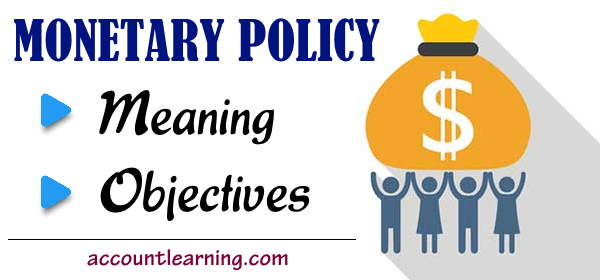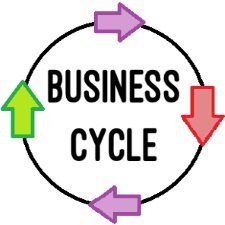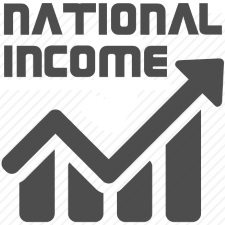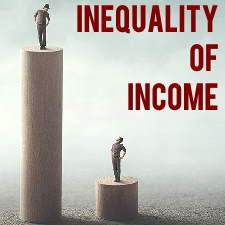Monetary Policy | Meaning | Objectives
Table of Contents
What is Monetary Policy?
Monetary policy refers to those measures adopted by the Central Banking authorities to manipulate the various instruments of credit control. The instruments of monetary policy are the same as the instruments of credit control at the disposal of the Central Banking authorities.
Raymond P. Kent defines monetary policy as
The management of the expansion and contraction of the volume of money in circulation for the explicit purpose of attaining a specific objective such as full employment.
Harry G. Johnson defines monetary policy as a
policy employing the Central Bank’s control of the supply of money, as an instrument for achieving the objectives of general economic policy
The control of credit in the economic system or the adoption of a definite monetary policy is done with a specific objective. Let us see what are the objectives of monetary policy.

Objectives of Monetary Policy
Objectives of monetary policy will be changing from time to time and from country to country depending upon the exigencies and the requirements of the nation. In the pre-Keynesian times, economists stressed the objective of the exchange-rate stability as the keel of monetary policy.
The period of Great Depression resulting in mass unemployment shifted the objective to “Full Employment” as the core of monetary policy. In the post-war period, economic growth at rapid strides is considered to be the main objective of monetary policy. It may so happen that countries adopting a monetary policy with different objectives may come across with conflicting objectives. In such cases, a compromise has to be evolved by setting definite priorities.
The major objectives of the monetary policy can be set in as follows:
- Stability of foreign Exchange Rate
- Price stability
- Economic stability
- Full employment
- Economic growth with stability
1. Stability of Foreign Exchange Rate
To maintain the stability of Foreign exchange rate is one of the objectives of monetary policy. It is a question of choosing between a stable domestic price level and a stable foreign exchange rate.
A stable exchange rate is imperative in ensuring successful functioning of international trade, stimulating favorable investment and also of the operation of gold standard. The greatest defect of this policy is that prices and employment would fluctuate widely with the movements of gold in and out of the country. Under the gold standard, exchange stability was attained at a heavy price of unstable domestic prices and the severe price instability has led many countries to break the rules of the gold standard.
With the fall of the gold standard, the stability of exchange rate is not considered to be a very important objective of monetary policy. Rather maintenance of domestic price stability is given priority. With the establishment of the International Monetary Fund, the importance of this objective of exchange rate stability has lost much of its importance.
2. Price Stability
The havoc caused during the period of “Great Depression” made the economists and administrators realize the importance of price stability in the economy to be embodied as the primary objective of monetary policy. The countries of the world were worst hit during the Great Depression of the thirties with prices falling to the rock bottom level and the attended evils in the economy. Similarly the countries had equally experienced the unpleasant adverse effects due to soaring prices at the time of world wars.
A rising price level creates problems and hardships to the fixed income group. A declining price-level creates complicated problems of production and distribution.
Another danger in price instability is its cumulative effect. When once the instability starts, it will gather momentum, threatening in course of time the entire economic order as well as political stability. World economic history gives ample proof to show that periods of fluctuating prices have been the periods of political and economic upheavals.
Keynes advocated price stability as the major goal of the monetary policy. Price stability received official recognition during the depression and it was embodied in the ‘New Deal’ programme of U.S.A., during the regime of F.D. Roosevelt.
Economists criticized price stability as a monetary policy on the following grounds:-
1. Internal prices change not only due to monetary causes, but also due to non-monetary causes and hence it cannot be treated exclusively as a goal of monetary policy.
2. If prices are kept stable for a long time, it will not give proper incentive to investment and ultimately this will lead to economic stagnation.
3. Hayek criticizes the objective of price stability as ignoring the real requirements of dynamic society. According to him, the adoption of monetary policy in U.S. had worsened position and the depression lasted longer. He felt that monetary authorities interfere in economic activity with their instruments either much earlier or much later than it is necessary.
4. Further, it is criticized that the objective of the monetary policy should be stabilization of the price of factors of production and not prices of commodities. In fact, changes in prices in different sectors of the economy in response to changes in supply and demand will be helpful in correcting maladjustment in the economy.
5. Price stability as a monetary objective is suitable for those countries which are agricultural and large in size and in which foreign trade plays an insignificant role. In other countries, stability of prices does not necessarily lead to stability of business conditions.
The objective of monetary policy is no longer restricted to price stability. It covers a wider range like economic stability, full employment and growth.
3. Economic stability
Economists view business cycle as “monetary phenomenon”. They advocate strict control over supply of money in order to avoid economic instability. According to them, during boom period the banking sector should contract credit and regulate the supply of money so that the inflationary spiral could be assuaged.
During depression, the banking sector is expected to expand credit to stimulate economic activity. Tackling economic fluctuation was considered to be the goal of monetary policy. However, the myth had been exploded during the period of depression.
Any amount of expansion of credit by banks could not persuade businessmen to increase investment and boost economic activity. This was because the businessmen lost confidence and they did not expect a reasonable rate of return. The marginal efficiency of capital was too low to encourage investment by businessmen. Contraction of the credit may stop a boom, but expansion of credit by itself cannot give a leverage effect to investment and boost economic activity unless the marginal efficiency of capital is high. So, as a weapon to restore economic stability, monetary policy failed.
4. Full Employment
With the publication of Keynes “General Theory”, full employment has been advocated as the important goal of monetary policy. Keynes himself has said:
the object of a monetary policy should be to reduce the ebb and flow of the trade cycles and bring about equilibrium between saving and investment at the point of full employment.
In the pre-Keynesian days, the monetary policy tried to cure the depression by making more funds available at the low rates of interest. But the inadequacy of such a policy was demonstrated during the period of depression when the desire for liquidity made it possible to increase funds for investment.
Further, Keynes analysis brought to light the need for utilizing the available resources to full employment level. He pointed out the monetary policy should be aimed at solving the unemployment problem by expanding consumption and investment expenditure. Since consumption function is more or less stable during the short period, the monetary policy should stimulate investment expenditure.
In order to increase the volume of investment, cheap money policy should be followed to stimulate borrowing and increase the level of employment through multiplier-acceleration effect. When once the level of full employment is reached, then the monetary policy should aim at maintaining the full employment level through equality between saving and investment.
Though the concept of full employment has attained full recognition to be the objective of monetary policy, it is somewhat vague. The concept calls for the employment of all the available resources. It would be better if we use the term “optimum employment” instead of “full employment”. The former denotes the level of utilization of economic resources which leads to the highest national income. Instead, if we use the labour force fully under full employment we might be forced to choose combinations of the factors of production which yield a considerably smaller social product (i.e., national income) than the optimum combination which leaves some of the available means of production unemployed.
5. Economic Growth Stability
The concept of Economic growth as the objective of monetary policy is the outcome of modern welfare aims practiced by Socialistic States. It is a step forward in establishing welfare ideals in the economy.
It has been recognized by modern welfare states that achieving full employment level is not enough but the standard of living of the people should go up by making the economy grow up at an accelerated pace. Economic growth implies qualitative and quantitative increase in the volume of goods and services produced in the economy which signifies the sustained increase in the per capita real income of the people. For this, two things are essential:
- that the economy’s productive capacity should increase and
- there should be a corresponding increase in demand for goods and services whose supply has increased.
If the productive capacity is larger and the demand lesser, there will be idle plant capacity resulting in unemployment. On the other hand, if the demand is in excess of productive capacity of the nation, prices will rise and ultimately the economy has to face inflationary spiral. So the monetary policy should aim at maintaining equilibrium between total money demand and total productive capacity.
‘Growth with stability’ has become the new objective of developing economies. The monetary policy is aimed at regulating the money supply on one side and encourage productive activities on the other side with care to see that speculative activities are curbed.
Reconciliation of Conflicting Objectives
The objectives of monetary policy discussed may be inconsistent with each other. In practical implementations, the objective may be conflicting. For example, after the war many sectors faced post-war recession, employment and income started declining. But at the same time the prices of consumer goods continued to rise for several months after the war period. In such a situation the objectives become conflicting. Since prices were rising, a tight money policy was called for to stabilize prices; but the declining employment and business activity warranted easy money policy. In such situations, the monetary authorities had to make choices. The choice should be in the best interest of the country as a
whole depending on the circumstances.



